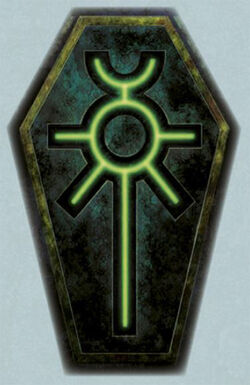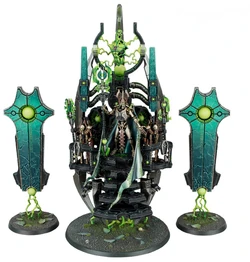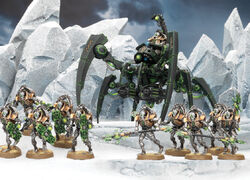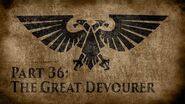
The Ankh of the Triarch, ancient royal symbol of the unified Necrontyr Empire used by every current Necron dynasty.
The Triarch was the ruling triumvirate of the ancient Necrontyr Empire before the outbreak of the War in Heaven over 60 million standard years ago.
From the earliest days, the rulers of individual Necrontyr dynasties were themselves governed by the Triarch, a council of three powerful phaerons. The leader of the Triarch was the phaeron known as the "Silent King," for he addressed his subjects only through the other two phaerons who ruled alongside him.
Nominally a hereditary position, the uncertain life spans of the ancient Necrontyr ensured that the title of Silent King nonetheless passed from one royal dynasty to another many times over the course of the Necrontyr's history.
The final days of the Necrontyr and their biotransference into the undying robotic Necrons occurred during the reign of Szarekh, who would prove to be the last of the Silent Kings.
Following the War in Heaven, when the Necrons revolted against their C'tan masters under the leadership of Szarekh, the two other members of the Triarch were slain, and no other Necrons ever took their place before the Triarch was disbanded following the start of the Necrons' Great Sleep.
Whilst the Silent King Szarekh returned to the Milky Way in 744.M41 from his long sojourn in intergalactic space to help his race meet the challenge of the Tyranid assault on the galaxy and the rise of the Imperium of Man and the growing threat of Chaos, he has made no move as yet to recreate the Triarch.
Ankh of the Triarch

The Silent King Szarekh aboard the Dias of Dominion alongside his fellow Triarch members Hapthatra the Radiant and Mesophet the Shadowed Hand. Notice the imprisoned C'tan known as the Enchained captured at the top of the Dias.
All Necrons bear the mark of the Triarch, a brand upon their necrodermis skin that binds them to their race's ancient heritage.
In the 41st Millennium, the absence of the Silent King and the long years of the Great Sleep have transformed the Ankh of the Triarch into a reminder of faded glory.
Some Necron Dynasty nobles still see the symbol as the foundation of the Necron Empire to be reborn, others merely as an echo of a long-dead age. However, the Ankh remains a symbol of the Necrons, and even those who have lost faith in its power still bear it on a cartouche adorning their metallic torso.
Despite cosmetic alterations, the shape of the Ankh remains unchanged, each exacting curve and line perfectly reproduced. Each dynasty also has its own glyphs, variations on the Ankh that identify its soldiers as part of a particular phaeron's armies.
These symbols are sometimes worn alongside the Ankh of the Triarch, but are usually secondary in size and placement, mirroring the ancient relationship between the dynasty's phaeron and the empire's governing Triarch.
Triarch Praetorians

The forces of the Triarch, including Triarch Praetorians and a Triarch Stalker, march to war.
The Triarch was served by elite Necron units known as Triarch Praetorians. The Triarch Praetorians are a specialised caste of Necrons who serve as the judges and enforcers of ancient Necrontyr law.
They are tasked with ensuring that every Necron dynasty upholds the terms of the ancient codes of law of the Necrontyr Empire to ensure that they are never forgotten nor ignored. From their initial creation in the eons before the War in Heaven to the end of the 41st Millennium, their task has remained unchanged, and they strive endlessly to see the Necrontyr Dynasties of old restored.
In the ancient Necron dynasties, the Praetorians were responsible for maintaining the Triarch's rule and to ensure that wars and politics alike were pursued in accordance with the ancient codes of behaviour of the Necrontyr. As such, they acted outside the traditional political structures, and held both the right and the means to enforce their will should a Necron Lord, Necron Overlord or even a phaeron's behaviour contravene the edicts of old.
However, the Triarch Praetorians also held a higher responsibility: to ensure that the Necron dynasties never fell, and that their codes of law and order did not vanish into the darkness.
In this, they eventually failed. To all intents and purposes, the War in Heaven saw the destruction of the Necron dynasties. Though the Triarch Praetorians fought at the forefront of that cataclysm, their efforts were simply not enough.
That shame of failure hung heavy on the survivors and drove them to forsake the blissful forgetfulness of hibernation. As the final sparks of the War in Heaven burnt out, the last Triarch Praetorians withdrew to the Necrontyr's ancient seats of power on the Northern Galactic Rim, preserving what they managed to safeguard of their ancient codes, laws and strictures from the vengeance of the Aeldari.
Triarch Praetorians often rode to battle in the hexapedal combat walkers known as Triarch Stalkers. Like an enormous mechanical spider, a Triarch Stalker looms over the battlefield with its multiple slicing limbs and devastating weaponry.
Triarch Stalkers are often piloted by a high-ranking Triarch Praetorian and are primarily employed against enemy heavy armour and to provide close fire support to other Necron units.
Videos
Sources
- Codex: Necrons (5th Edition), pp. 6, 9, 23-24, 38-39
- White Dwarf 450 (January 2020), "Last of the Silent Kings," pp. 28-33

